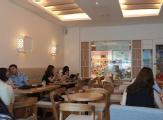Starbucks, Cafe Bene, Pascucci, Holly’s Coffee, Ediya. There are more five cafes situated within 300 meters around Soongsil University. All these cafes are always crowded. Nowadays, cafes are so common and have created their own culture: the cafe culture. Where and when did the cafe start?
The cafe's beginning
Cafes started from the invention of coffee. The stories about the origin of coffee vary, and no one can tell its exact origin. Experts theorize that coffee originated from Africa or Arabia partly because these countries have the ideal climate for growing coffee trees. The coffee The Arabians drank spread out to other places. The caffeine contained by coffee makes people less tired and more alert, and this effect made the Europeans drink more coffee. They thought it was a kind of medicine because of the caffeine. Sometime in the 16th century, a coffee house was opened in England. It became a place where adult males discussed and exchanged information until late at night because the coffee made them less tired. This coffee house spread out to Paris, and its name was Gallicized into cafe. In the cafe, they started to sell other beverages, and it became very similar to the ones at present.
The cafes in the West
The cafe became very popular among the adult men in Europe; it was the place where they could collect information and show off their knowledge. The women started to complain because they were banned from the cafes. The solution was tea. Along with coffee’s popularity, the curiosity about the East grew stronger. There were a lot of amazing products in the East, such as spices and tea. These products started to be imported by Europe. Tea became a source of joy for the women, who were not allowed to drink coffee and to go to the cafes. The women started to drink tea, and soon after, the men also started to fall in love with it. In England, tea time, when people drank black tea and ate sweet desserts to go with it, became so popular that it eventually eclipsed coffee.
The current cafes in the West
People started drinking coffee more than 300 years ago. The cafe has become a place not only for talking but also for munching on food and for getting some work done. The purpose and function of cafes have thus become more diverse. For example, J. K. Rowling wrote Harry Potter in Edinburgh’s cafe, and N. H. Jon Favreau, a director of speech writing, wrote Obama’s presidential nomination acceptance speech in Starbucks.
The first cafe in South Korea

According to the official records, King Kojong (1852-1919) was the first Korean who tasted coffee. Antoinette Sontag introduced coffee to Kojong when he moved to the Russian embassy due to the military threat posed by Japan. King Kojong gave a building to Sontag in gratitude for his goodness to him, and for giving him coffee. Sontag turned this building into a hotel, and the first coffee house in Korea, Jeongdong Gurakbu, was a part of this hotel. This was the first coffee house in Korea, and it became a place that was frequented by the rich Koreans and foreigners. It got burned down in 1957, and only traces of it remain today.
The current cafes in South Korea
The South Korean cafes were inspired by the Western cafes, and thus, the purpose and function of the cafes in South Korea are very similar to those of the Western cafes. ST conducted a survey about how the cafes are seen by 73 university students. The survey results showed that most students go to cafes to meet their friends while some students go there to eat desserts and to do their work. In response to the question “How can cafes be improved to serve you better?,”most students said that they need private places in cafes while some said that they need more outlets for charging their laptops or cell phones. These answers indicate that people want more work-friendly facilities. The conventional function of the cafe is now undergoing changes.
Nowadays, you can enjoy a variety of things in cafes. There are many kinds of cafes that can meet the diverse interests and needs of the public: dog cafes, cat cafes, book cafes, etc. Also, the new type of cafe is the fusion cafe. This cafe combines the contents of the traditional and modern cafes. Cafe Ogada (five traditional teas) sells traditional beverages like traditional teas (e.g., mugwort tea, Asian apricot lemon tea) and unique desserts like injeolmi (rice cake with powdered dried soybeans) bread, Jeju hanrabong ice flakes, and hongsi (soft persimmon) ice flakes. Also, this cafe was designed like a traditional Korean house to create an atmosphere of tradition and refinement.
Cafes were preserved by the European men and by the royal people in Korea. Nowadays, however, cafes are very common places. We can see them everywhere, and everyone can go there and enjoy. Their purpose is also changing. They were just for having coffee in the past, but now, we even do our work in cafes. The changes do not seem to be limited to this planet. Perhaps there will also be cafes in space shuttles or in other planets in the future. What do you think is the future of cafes?





